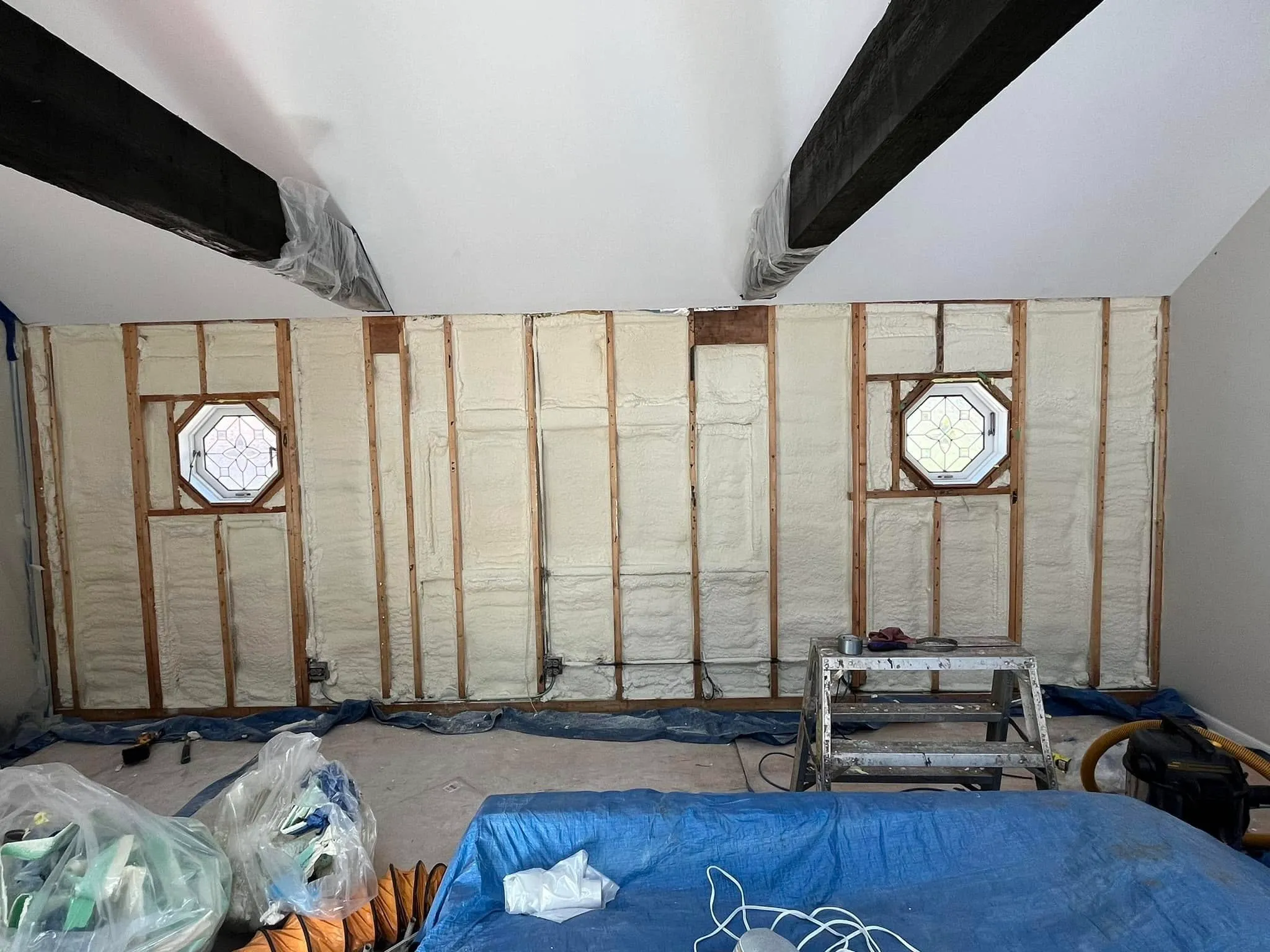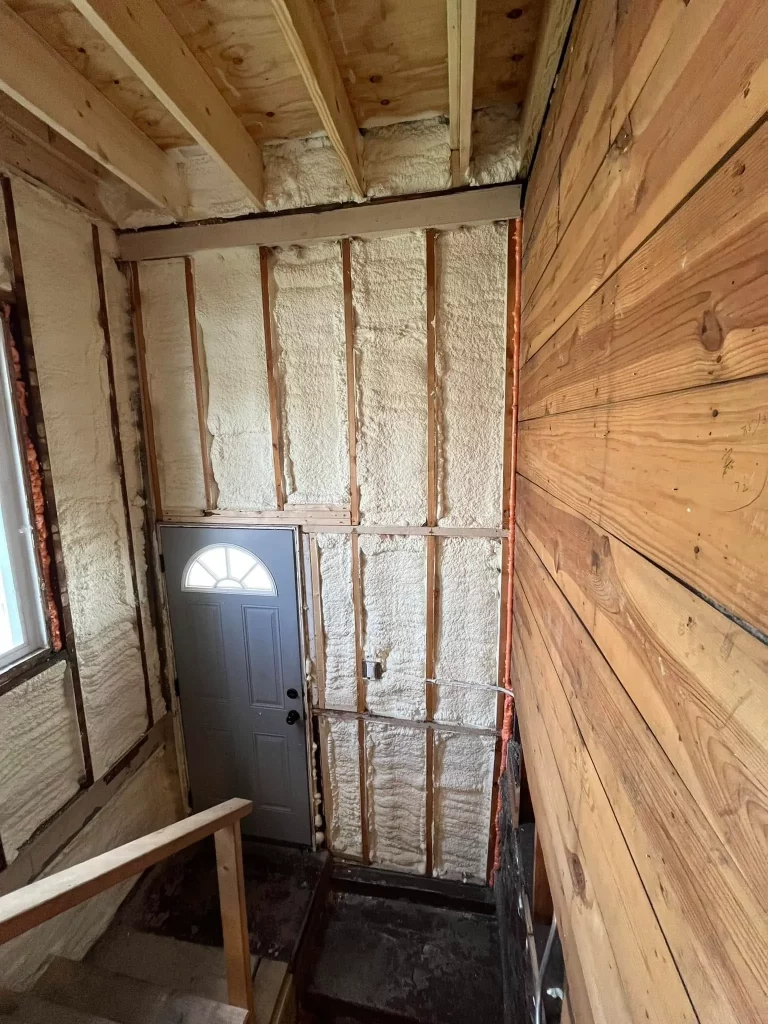
Spray foam insulation delivers superior thermal performance for Chicago winters through its dual-action sealing and insulating properties. Unlike traditional insulation materials that allow air infiltration, spray foam creates an airtight barrier that eliminates thermal bridging and moisture infiltration—two critical factors that compromise indoor comfort during Chicago’s harsh winter conditions with temperatures regularly dropping below 10°F.
The effectiveness stems from spray foam’s ability to expand and fill every gap, crack, and cavity within building structures. This comprehensive coverage prevents the stack effect that drives warm air upward and draws cold air into living spaces. Based on extensive field experience across Chicago’s diverse housing stock, buildings insulated with spray foam maintain consistent temperatures with 30-40% less energy consumption compared to homes using traditional insulation methods.
Chicago’s continental climate presents unique challenges that standard insulation materials struggle to address effectively. Winter temperatures frequently fluctuate between -10°F and 35°F, creating constant expansion and contraction cycles that exploit weaknesses in building envelopes. The city experiences an average of 6,536 heating degree days annually, significantly higher than the national average of 4,000-5,000 degrees.
Wind chill factors compound thermal challenges, with Lake Michigan’s proximity creating sustained winds that drive cold air through even minor building imperfections. Traditional insulation materials like fiberglass batts lose thermal resistance when air moves through them, reducing their effectiveness by up to 50% in windy conditions.
Bonus Tip: Chicago’s freeze-thaw cycles cause building materials to shift, creating new gaps over time. Spray foam’s flexibility allows it to maintain sealing properties despite these structural movements.
| Insulation Type | R-Value per Inch | Air Sealing | Moisture Control | Longevity | Installation Gaps |
|---|---|---|---|---|---|
| Closed Cell Spray Foam | 6.0-7.0 | Complete | Vapor barrier | 50+ years | None |
| Open Cell Spray Foam | 3.5-4.0 | Complete | Permeable | 50+ years | None |
| Fiberglass Batts | 3.2-3.8 | None | None | 15-20 years | Common |
| Blown-In Cellulose | 3.2-3.8 | Minimal | Settles over time | 20-30 years | Settling gaps |
| Rigid Foam Boards | 4.0-6.5 | Seams only | Limited | 25-30 years | Joint gaps |

Spray foam’s thermal properties remain consistent across Chicago’s temperature extremes. Closed-cell spray foam maintains structural integrity at temperatures as low as -40°F, while open-cell varieties perform effectively down to -20°F. This stability ensures consistent performance throughout winter months when heating demands peak.
The material’s low thermal conductivity coefficient (0.16-0.20 BTU·in/hr·ft²·°F for closed-cell) provides superior resistance to heat transfer compared to traditional materials. This translates to measurable energy savings during Chicago’s extended heating season from October through April.
| Performance Metric | Closed Cell Spray Foam | Open Cell Spray Foam | Fiberglass Batts |
|---|---|---|---|
| Thermal Conductivity | 0.16-0.20 BTU·in/hr·ft²·°F | 0.25-0.28 BTU·in/hr·ft²·°F | 0.32-0.40 BTU·in/hr·ft²·°F |
| Air Permeability | <0.02 L/(s·m²) @ 75 Pa | 1.5-3.0 L/(s·m²) @ 75 Pa | >15 L/(s·m²) @ 75 Pa |
| Moisture Permeance | <1.0 perm | 15-20 perms | No barrier |
| Temperature Range | -40°F to 250°F | -20°F to 180°F | -50°F to 180°F |
Bonus Tip: Install spray foam when outdoor temperatures exceed 40°F for optimal expansion and curing. Chicago’s unpredictable spring weather requires flexible scheduling for exterior applications.
Chicago’s proximity to Lake Michigan creates elevated humidity levels that traditional insulation materials cannot effectively manage. Spray foam’s vapor barrier properties prevent moisture infiltration that leads to mold growth, structural damage, and reduced thermal performance.
Closed-cell spray foam acts as a Class I vapor retarder with permeance ratings below 1.0 perm, effectively blocking moisture transmission through building assemblies. This characteristic proves essential in Chicago basements and crawl spaces where groundwater moisture frequently compromises traditional insulation systems.
The material’s closed-cell structure prevents water absorption, maintaining thermal properties even when exposed to moisture. Field observations across Chicago installations demonstrate that spray foam-insulated spaces maintain relative humidity levels 15-20% lower than comparable spaces with traditional insulation.
Installation timing significantly impacts spray foam performance in Chicago’s climate. Schedule applications during moderate weather conditions when outdoor temperatures remain between 40°F and 85°F for 24-48 hours post-installation. This timing ensures proper curing and optimal adhesion to building surfaces.
Ventilation requirements during installation necessitate temporary relocation for occupied spaces. Professional installers must maintain proper air circulation and temperature control throughout the curing process. Building codes in Chicago require specific ventilation protocols that certified contractors understand and implement.
Budget considerations should account for spray foam’s higher initial investment compared to traditional materials. However, energy savings typically offset installation costs within 3-5 years in Chicago’s climate. Property value increases of 5-10% commonly result from professional spray foam installations.
Existing building conditions require thorough evaluation before spray foam application. Moisture problems, electrical issues, or structural concerns must be addressed prior to installation to ensure optimal performance and prevent future complications.
Bonus Tip: Conduct blower door tests before and after spray foam installation to quantify air sealing improvements. Chicago homes typically achieve 30-50% reduction in air infiltration rates.
South Chicago Insulation specializes in comprehensive insulation solutions designed for Chicago’s demanding climate conditions. Professional installation ensures optimal performance and longevity of spray foam systems.
Homeowners frequently ask about installation timeframes and occupancy requirements during spray foam applications. Most residential installations require 1-3 days depending on project scope, with 24-hour occupancy restrictions following closed-cell applications and 4-8 hour restrictions for open-cell installations.
Building code compliance questions arise regularly regarding spray foam applications in Chicago. Professional installers ensure all installations meet local building codes and energy efficiency requirements. Permits may be required for extensive renovations involving spray foam insulation.
Performance expectations center on energy savings and comfort improvements. Properly installed spray foam systems typically reduce heating costs by 20-40% in Chicago homes while eliminating cold drafts and temperature variations between rooms.
Long-term maintenance concerns focus on inspection schedules and potential repairs. Spray foam insulation requires minimal maintenance once properly installed, with periodic visual inspections recommended to identify any building movement or settling that might compromise sealing integrity.
Spray foam insulation provides unmatched performance for Chicago’s extreme winter conditions through superior thermal resistance, complete air sealing, and effective moisture management. The investment delivers measurable energy savings, improved comfort, and increased property value over the material’s 50+ year lifespan.
Evaluate your specific needs based on building age, existing insulation condition, and energy efficiency goals. Professional assessment identifies optimal spray foam applications and installation strategies tailored to your property’s unique characteristics and Chicago’s climate demands.
Making informed decisions about insulation upgrades requires understanding your property’s specific needs and performance goals. South Chicago Insulation brings extensive experience in spray foam applications across Chicago’s diverse housing stock, ensuring optimal results for every project.
Professional consultation evaluates your building’s current thermal performance and identifies areas where spray foam delivers maximum benefit. Certified installers ensure code compliance and proper application techniques that maximize energy savings and comfort improvements.
Contact South Chicago Insulation at [email protected] or (779) 803-8025 to schedule a comprehensive evaluation of your property’s insulation needs and discuss spray foam solutions designed for Chicago winters.
Properly installed spray foam insulation maintains its thermal and sealing properties for 50+ years in Chicago conditions. The material’s chemical structure remains stable through repeated freeze-thaw cycles and temperature fluctuations common in the region.
Yes, spray foam significantly reduces ice dam formation by eliminating air leakage that causes uneven roof temperatures. Complete attic sealing prevents warm air from reaching roof surfaces, maintaining consistent snow coverage and preventing melt-refreeze cycles.
Professional spray foam installation is possible during winter months when indoor temperatures exceed 65°F and outdoor temperatures remain above 20°F. Controlled environment conditions ensure proper curing and optimal adhesion properties.
Closed-cell spray foam excels in Chicago basement applications, providing thermal insulation, moisture control, and structural reinforcement. The material adheres directly to concrete surfaces and prevents moisture infiltration common in below-grade installations.
Spray foam insulation requires minimal maintenance once properly installed. Annual visual inspections identify any building movement or settling that might create new thermal bridges, though such issues rarely occur with professional installations.